
Inferno is a fantasy role-playing game published by Death's Edge Games in 1994.

Inferno is a fantasy role-playing game published by Death's Edge Games in 1994.
Inferno is a role-playing game set in Hell. The player have a choice between playing a heroic player character who tries to rescue the souls of the innocent that have been taken by evil forces and aids damned spirits struggling to achieve redemption; or an evil necromancer seeking to conquer Hell. [1] In addition to role-playing rules, the book also contains magical spells, and a compendium of infernal creatures. [1]
Players choose one of four races (mortal, shade, hellspawn, or imp), and roll dice to create the character's attributes. Players then choose a class, which also determines faith status from Faithful to Infernal. Faithful characters are more constrained in terms of actions and magic, but Infernal characters have no protection from more powerful evil beings. To finish the character, the player purchases skills using a pool of creation points. [1]
To resolve both skills and combat, the player must roll a twenty-sided die and get the same or less than the target number. For every two points by which a combat roll succeeds, an additional point of damage is done. [1]
Inferno is a 136-page perfect-bound book written by Gabe Ivan, with illustrations by Thom Thurman and Sean Parrack, and was published by Death's Edge Games in 1994. The following year, Death's Edge published an expansion supplement, Gods of Hell, and an adventure, Out of the Abyss. No further publications were released.
In the August 1994 edition of Dragon (#208), Lester W. Smith thought "The game system itself is quite good." But despite this, he believed the game's divide between good and evil players was a built-in weakness. He foresaw that most players would opt for Infernal characters, and then rapidly get bored "with having their characters torment less powerful creatures, and will become frustrated when their own characters suffer at the hands of creatures more powerful than they." He concluded by giving the game an average rating of 4 out of 6, predicting that most players "will just toss the book and go back to their video games." [1]
In the January–February 1995 edition of Shadis (Issue 17), Dirk Dejong didn't think this was the most innovative on the market, except for the setting of Hell, which he thought was ingenious. But he liked the tone of the game, and concluded with a strong recommendation, saying, "It's new, it's funny, it has the capacity to scare the pants off of you, and it gives the good guys a good name once more (as well as giving players a reason to be good)." [2]
A copy of Inferno is held in the collection of the Strong National Museum of Play (object 110.2414). [3]

The Whispering Vault is a horror-themed role-playing game originally published in 1993. Players take on the role of "Stalkers", persons who have risen above their own mortality to act as servants of the guardians of Reality, tracking down and apprehending rogue gods who have invaded Reality and returning them to the realm of the Unseen where they are cast into The Whispering Vault.

Deadlands is a genre-mixing alternate history role-playing game which combines the Western and horror genres, with some steampunk elements. The original game was written by Shane Lacy Hensley and published by Pinnacle Entertainment Group in 1996.

Chill is an investigative and modern horror role-playing game originally published by Pacesetter Ltd in 1984 that captures the feel of 20th-century horror films.
The tiefling is a fictional humanoid race in the Dungeons & Dragons (D&D) fantasy roleplaying game. Originally introduced in the Planescape campaign setting in the second edition of Advanced Dungeons & Dragons as a player character race for the setting, they became one of the primary races available for player characters in the fourth edition of the game.

Castle Falkenstein is a steampunk-themed fantasy role-playing game (RPG) designed by Mike Pondsmith and originally published by R. Talsorian Games in 1994. The game is named for a legendary unbuilt castle in the Bavarian Alps. Players play the roles of gallant adventurers who take on quests of intrigue and derring-do in the spirit of Victorian adventures such as The Prisoner of Zenda.
In the fantasy role-playing game Dungeons & Dragons, an Outer Plane is one of a number of general types of planes of existence. They can also be referred to as godly planes, spiritual planes, or divine planes. The Outer Planes are home to beings such as deities and their servants such as demons, celestials and devils. Each Outer Plane is usually the physical manifestation of a particular moral and ethical alignment and the entities that dwell there often embody the traits related to that alignment.
A devil, also referred to as a baatezu, is a group of fictional creatures in the Dungeons & Dragons (D&D) roleplaying game typically presented as formidable opponents for advanced players. Devils are characterized by their Lawful Evil alignment and are depicted as originating from the Nine Hells of Baator. They follow a strict and hierarchical structure, progressing through various forms as they rise in rank. At the top of this hierarchy are the Archdevils, also known as the Lords of the Nine, who govern different regions within Baator. Devils are often portrayed as seeing the various worlds in the D&D universe as tools to be exploited for their objectives, such as participating in the Blood War—a centuries-long conflict against demons.
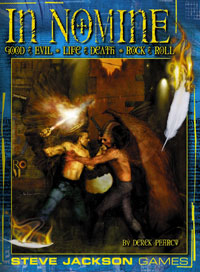
In Nomine is a role-playing game designed by Derek Pearcy and published in 1997 by Steve Jackson Games, based on the French game In Nomine Satanis/Magna Veritas. Players typically assume the role of angels and demons in a setting that draws heavily from traditional Christianity.

Shadis is an independent gaming magazine that was published in 1990–1998 by Alderac Entertainment Group (AEG). It initially focused on role-playing games.

Dragon's Lair II: Time Warp is a 1990 laserdisc video game by the Leland Corporation. It is the first true sequel to Dragon's Lair. As with the original, Dragon's Lair II: Time Warp consists of an animated short film that requires the player to move the joystick or press a fire button at certain times in order to continue. It takes place years after the original Dragon's Lair. Dirk has married Daphne, and the marriage has produced many children. When Daphne is kidnapped by the evil wizard Mordroc in order to be forced into marriage, Dirk's children and his mother-in-law are clearly upset by the abduction of Daphne, and Dirk must once again save her.
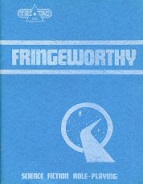
Fringeworthy is an alternate history role-playing game published by Tri Tac Games in 1982 that involves playing characters who have the ability to travel to different versions of Earth. It was the first role-playing game to explore the genre of alternate worlds.
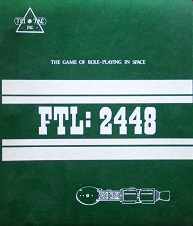
FTL:2448 is a science fiction role playing game published by Tri Tac Games in 1982 in which players use a faster-than-light (FTL) spaceship as a commercial enterprise, doing whatever it takes to buy enough fuel for the next voyage. This could involve trade, espionage, exploration, war or police work.
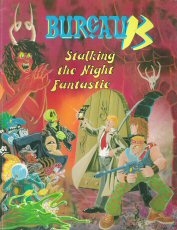
Bureau 13: Stalking the Night Fantastic is a satirical science fiction/horror tabletop role-playing game published by Tri Tac Games in 1992.
The Ranger is one of the standard playable character classes in most editions of the Dungeons & Dragons fantasy role-playing game. Rangers are skilled bushcraftsmen/woodcraftsmen, and often lived reclusive lives as hermits.
The paladin is one of the standard playable character classes in most editions of the Dungeons & Dragons fantasy role-playing game. The paladin is a holy knight, crusading in the name of good and order, and is a divine spellcaster.

The Complete Book of Humanoids is a sourcebook for the second edition of the Advanced Dungeons & Dragons fantasy adventure role-playing game.
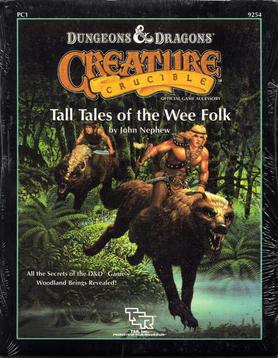
Tall Tales of the Wee Folk is an accessory for the Dungeons & Dragons fantasy role-playing game.

Gatecrasher is a light-hearted science fantasy role-playing game published by Grey Ghost Press in 1996.

Inferno is an adventure for fantasy role-playing games published by Judges Guild in 1980.